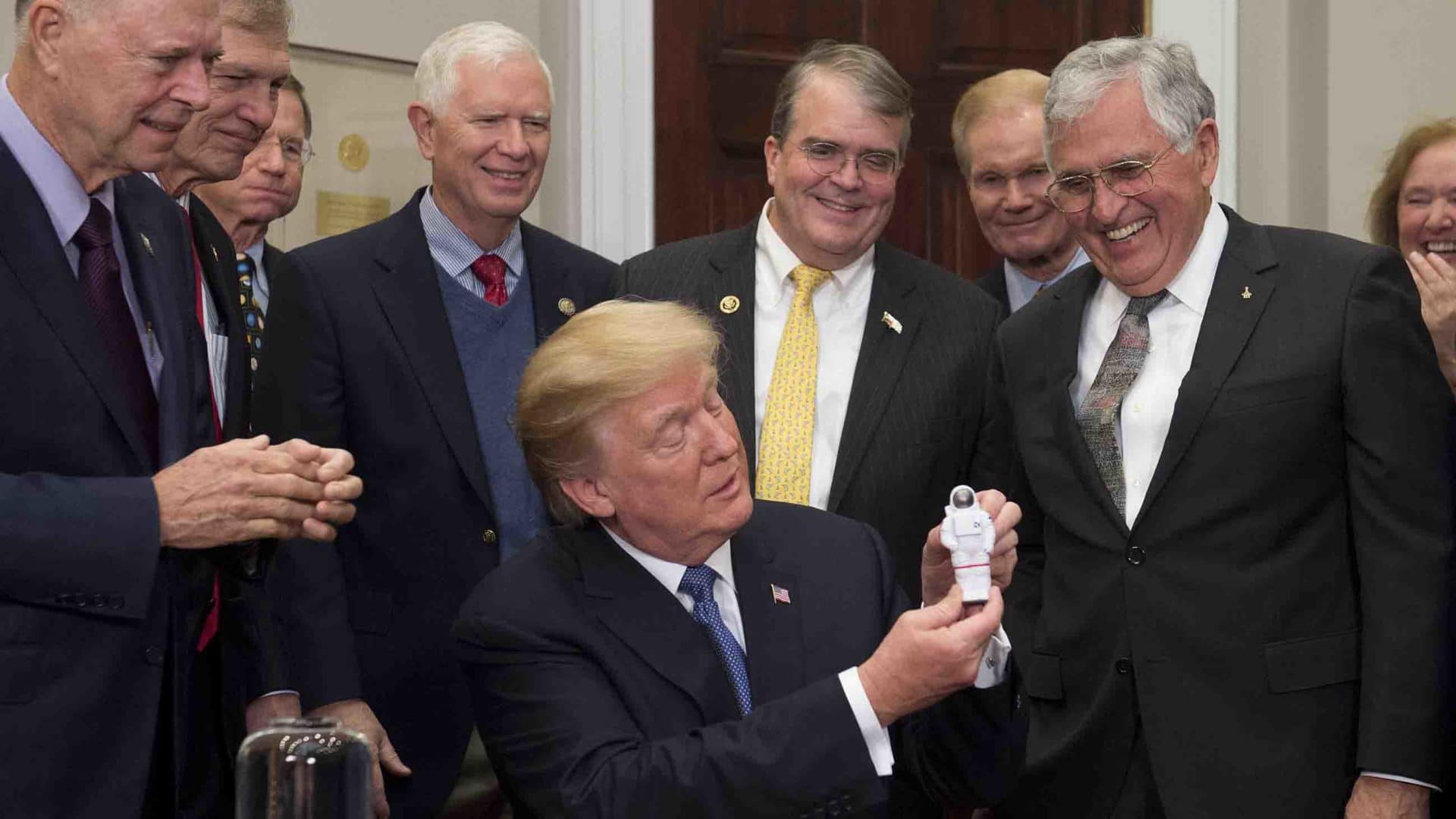VIEWPOINTS: Partner content, op-eds, and Undark editorials.
This year marks the 50th anniversary of the Apollo 11 mission, the culmination of the U.S. government’s eight-year effort to land the first human on the moon. Between 1962 and 1972, the Apollo program — which saw a total of six crewed landings — cost $25 billion ($144 billion in today’s dollars). Despite NASA’s comparatively small present-day budgets, the Trump administration has now announced that it wants to send astronauts back to the lunar surface by 2024.
So far, Trump has provided few details about how he’ll achieve the feat on such a rushed timeline and slim budget — he has as yet only asked for an extra $1.6 billion. And despite the campaign’s moniker, “Moon to Mars,” it could potentially delay Obama-era plans that were already on pace to send humans to the Red Planet in the 2030s or early 2040s.
Worse yet, the 2024 target date suggests a selfish motive — an attempt by Trump to conjure a dramatic legacy before he leaves office, assuming he is reelected next year. Indeed, recent comments by NASA Administrator Jim Bridenstine suggest the deadline was chosen with little, if any, consideration of the scientific and engineering challenges. At a recent space symposium, Vice President Mike Pence told attendees that Trump directed NASA to send astronauts to meet the deadline “by any means necessary,” and that “we must focus on the mission over the means.”
Perhaps most troubling, the Trump administration has left the public guessing as to what they hope to accomplish when they get to the moon. Judging from the administration’s expressed support for privatizing and commercializing space, the few available informational materials about the Moon to Mars project, and recent comments by Pence, the administration seems to be at least considering mining the moon for water, oxygen, and rare minerals. If so, we should worry: Not only would moon mining potentially run afoul of international law, it would set a dangerous precedent that our nearest neighbor’s resources are up for grabs.
The Moon to Mars project — recently renamed Artemis — stems from a 2017 policy recommendation from the National Space Council, a group led by Pence and advised by a who’s who of CEOs and COOs from space companies large and small. The council packaged its recommendations as Space Policy Directive 1, which was signed by Trump in December 2017. The directive calls for, among other things, a sustained human and robotic presence on and around the moon. That effort will include an orbiting space station known as “Gateway” that will serve as a base for expeditions to the surface of the moon.
For help achieving these lofty goals, the administration appears to be leaning heavily on the big players in the commercial space industry, including Boeing, Lockheed, and relative newcomers Space X and Blue Origin. Last fall, NASA selected nine companies for its Commercial Lunar Payload Services program; the companies are being eyed to shuttle government payloads to the moon and back.
Of course, these days commercial partnerships are essential to almost any large endeavor. What’s concerning about the Moon to Mars project is that the administration doesn’t seemed to have articulated a clear vision of space exploration that it wants to accomplish through those partnerships. It has shown little interest in answering big, longstanding questions about how our lunar companion formed or what its numerous craters tell us about asteroid impacts. Instead, the Trump administration seems singularly obsessed with getting boots on the lunar ground.
In the absence of a strong vision from the president, corporate interests can hold sway. And among those interests, it seems, is mining the moon.
At least one of NASA’s partners, Moon Express, has been actively developing technologies that would allow it to mine the moon and return lunar material to Earth. In February, when NASA finally announced the first dozen instruments it planned to send to the moon, three were prospecting instruments. In a recent speech at the National Space Council, Pence reportedly spoke of plans to “mine oxygen from lunar rocks” and “extract water from the… craters of the south pole.” And though NASA’s glossy new Moon to Mars website presents plenty of hype and little information, a passage from its vague science section is suggestive: “Ice represents power. It represents fuel. It represents science.”
Moon mining isn’t a completely crazy idea. Lunar resources, especially water ice, could prove useful for journeys to Mars and beyond. Not only could water serve as rocket fuel for trips to deep space, it could be used for cooling, shielding from radiation, and, of course, drinking. And harvesting the moon’s water could turn out to be much more energy efficient than launching large quantities of it off the Earth.
But who has the right to extract water from the moon, and how would one avoid damaging the lunar surface in the process?
As it so happens, a pair of international laws have already begun to address these questions. The Outer Space Treaty of 1967 — signed and ratified by more than 100 countries, including the U.S. — establishes that the exploration of outer space must be done for everyone’s benefit and that no country or organization can appropriate any part of outer space. And the 1979 Moon Agreement, which the U.S. has not signed but which nonetheless constitutes international law for the small number of countries who have signed on, goes further. It states that neither the orbits around the moon nor its surface nor subsurface nor any natural resources there shall become the property of any country or private organization.
These restrictions of international law seem to prohibit commercial activity that involves extracting resources, owning property, or altering the moon’s surface. In other words, they establish that the moon is supposed to be like Antarctica, which hosts research stations but not commercial ones, and where tourists’ activities are restricted. But given President Trump’s willingness to consider deploying massive weapons in space as part of a “space force” — a militarization that would violate the spirit of the Outer Space Treaty as well as the United Nations longstanding agenda to prevent the weaponization of space — he doesn’t take international law particularly seriously.
If Trump’s new moon program indeed pursues mining, it would set a dangerous precedent. Claiming lunar land, wresting resources from it, and planting an outpost upon it harkens back to colonialism — not unlike the Trump administration’s approach to Puerto Rico, which remains a neglected colony that has suffered for its status, and Standing Rock, where indigenous peoples’ rights have mattered less than oil.
The international space treaties, on the other hand, have the right idea. Our moon — like the oceans, mountains, and forests — is supposed to be for everyone. Unfortunately, the moon has no dedicated environmental movement. So when it is threatened by half-baked policies and would-be prospectors, it’s up to us to protect it.
Ramin Skibba (@raminskibba) is an astrophysicist turned science writer and freelance journalist who is based in San Diego. He has written for The Atlantic, Slate, Scientific American, Nature, and Science, among other publications.











Comments are automatically closed one year after article publication. Archived comments are below.
What poor treatment of Puerto Rico? They don’t pay US income taxes and get some favorable tax treatment to encourage companies to locate there. It is less than it used to be but still, they get much more from the US than they contribute. It’s essentially a welfare state. It’s the US taxpayer that is shamefully treated!
On what little i know; mostly from sci-fi, there is an advantage in transporting from moon to earth as the gravity differential is to the moons advantage .
Being futuristic is what has got America so far. I believe no matter how expensive or preposterous the idea might be, it is important for US Space missions to go ahead with it, if they want to remain pioneers in space.
Now I’ll confess that I did not read this article too carefully.
And I’ll grant you that Trump is a world-historical dumb ass, so he might be inclined to think that there’s money to be made from mining on the moon.
But there’s no way in the world EVER that a profit can be made from taking something from the moon and then bringing it to earth. It’s a ludicrous proposition. Look at Apollo, send up a rocket that weighs a few million pounds at a cost of many billions to return a small capsule with 3 men, weighing what, a few thousand pounds? And they’re going to have a few pieces of gold in their pockets? After rooting around on the moon with who knows how much billion dollar gear and getting killed to dig up a few diamonds or a piece of gold? Or some water? (Which we do have in abundance down here already FYI). You’d have an easier time digging for gold at the bottom of the Marianas Trench – and even if you could find it down there, you’d still not make any money at it.
It’s scientific, engineering and economic illiteracy to discuss it as a rational notion. The money that it takes to get to the moon and back will not ever get “paid back in profit”. “Ice represents power. It represents fuel. It represents science.” This is science and technology talk by and for morons. It’s hard to know when a politician says crap like that whether they believe or if they just see the audience as a bunch of marks.
But perhaps Trump can make it happen. He’s not a politician, he’s a super billionaire and he’s got a really good brain. He’s a Dale Carnegie Man. I heard that his Uncle taught at MIT. He’s got a space force, maybe we should have a moon base with a moon force.
——————-
As for using water from the moon to make it easier to get to Mars, good luck with that.
–>Think for a moment about what it will cost to get to Mars in total. I don’t think the viability of the mission will hinge on that low-cost moon water. Seriously, it sounds almost humorous – low-cost moon water – like something from a standup act. Just park the ship in orbit and beam it up, Scotty.
The significant difference between colonizing the Moon and colonialism is that there are no people there already. In fact, there is no life there at all. The poor treatment of Puerto Rico and Standing Rock is shameful, but it literally cannot be repeated on the Moon.
The problem with the ’79 Agreement is that it hampers exploration of any sort. Despite their effort, the respective countries would not own the samples brought back by Apollo, Luna, and (if all goes well) Chang’e 5. Why take the risk? Why expend the cost? No, there has to be something to gain to motivate people. I think a better standard is the UNCLOS rules on exploitation of ocean resources. This allows commercial activity while preserving the principle of common heritage. If necessary, an economic zone could be allowed/limited to the vicinity of an outpost similar to the ISS’s “Keep-Out Sphere.”